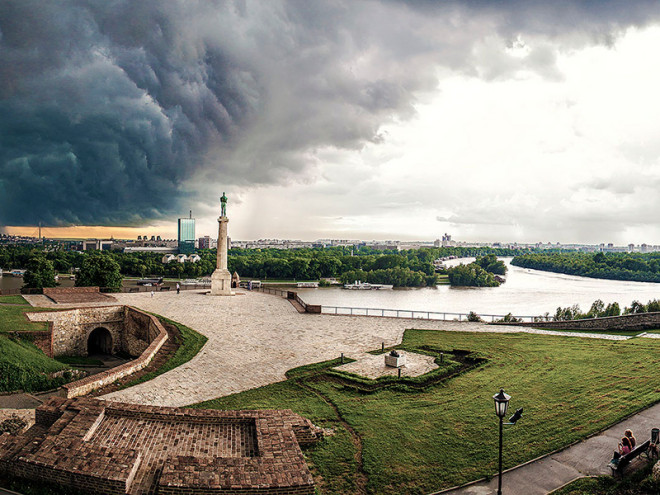
WHAT IS WORTH TO SEE IN BELGRADE
THE PRIMEVAL BEGINNINGS OF THE WHITE CITY
Belgrade Fortress and Kalemegdan Park are an open-air museum of the city’s history. Within the walls of the fort, there are a lot of monuments testifying of the development of the city from ancient to contemporary times. In the Upper City, there are: the Victor Statue – a city landmark, the Military Museum, the Roman Well, Ružica Church, Church of St. Petka, the Clock Tower… In the Lower City, worth visiting are an exhibition at Nebojsa Tower and the Belgrade Zoo.
THE STREET OF A NOBLE PRINCE
The pedestrian zone and the trading centre – Knez Mihailova Street and the Republic Square – are amongst the architectonically worthiest and liveliest parts of the city. The monument dedicated to Prince Mihailo and the palace of the Serbian Academy of Sciences and Arts are two most recognisable landmarks of the city centre. There are also the edifices of the National Theatre and the National Museum. The Ethnographic Museum, Princess Ljubica’s Residence, Serbian Orthodox Church Museum, the Zepter Museum, Museum of Applied Arts, Fresco Gallery as well as many other institutions of culture are located there.
SAVAMALA – A CREATIVE DISTRICT
One of the oldest and until recently neglected quarters is going through an exciting transformation and is again becoming the cultural focal point of the city. Visit Frıda Bar, Communale Restaurant and taste Serbian Food in Ambar Restaurant
THE BOHEMIAN QUARTER
There is a catch phrase, “Who has not been to Skadarlija has not been to Belgrade either.” On that old, cobbled street, there are famous inns: Three Hats, Two Deer, There Will Be Days, My Hat… They cherish the tradition of joyful hangout with old town music and specialties of the national cuisine. A gentleman’s cane, a carnation and a boater hat are the symbols of the quarter.
ST. SAVA’S TEMPLE
One of the largest Orthodox temples in the world was built on the spacious square in Vračar, where – toward the end of the 16th century – the Turks burnt the relics of St. Sava, the first Serbian archbishop and a great man of the national history. The temple has three galleries for choirs and can host about ten thousand people.
REMEBERING TITO AND SOCIALISM
The permanent exhibition of the Museum of Yugoslav History vividly witnesses about the history of the former Yugoslavia and the life and work of its legendary president Josip Broz Tito. The Museum consists of the Museum 25 May, the Old Museum and the House of Flowers.
OLD ZEMUN
Once on the very border of the two empires, Zemun still gives impression of the atmosphere of the Austrian-Hungarian Empire. Gardoš Tower, offering a panoramic view of the Danube, is the symbol of that extraordinary city. Paying tourist visits to the edifices worth being seen also includes a walk along the lively and arranged Danube bank. A sandy beach called Lido on the big War Island, which is Belgrade’s protected natural good, is yet another pearl of the city of Zemun
THE ROYAL COMPOUND
The Royal Palace and the White Palace testify of the history and refined artistic feel of the Serbian Karadjordjević Dynasty. Today, Heir to the Throne Aleksandar II lives at the Royal Palace, a showcase villa built in the Serbian-Byzantine style.
BELGRADE RIVERS – SAVA AND DANUBE
The riverbank zone of the city is its special treasure: popular rafts, clubs, the greenery… all these give a unique impression of the metropolis on the water. The quay at the confluence, Zemun Quay and the Sava River Harbour are only part of the space on the river banks offering different amenities: tourist sightseeing of the city from the rivers, going out to floating river clubs, riding bicycles, walking and watching the bridge
ADA CIGANLIJA
The Belgrade "sea" – a beautiful river lake surrounded by a wood, with a line of coffee shops, restaurants, bicycle trails and courts is the most beautiful recreational zone of the city. Ada offers one a view of the newly-erected bridge on the River Sava – a world construction miracle and a new symbol of the city.
TOPČIDER PARK
The court park, the court church and the oriental residence of the great Serbian ruler Miloš Obrenović speak volumes about liberation of Serbia from Turks. A magnificent old plane tree is its prominent feature.
AVALA
The Tower of Avala, located on the mountain of the same name, is yet another landmark of the city, testifying of the power of Belgrade to raise itself out of the ashes. Destroyed in the 1999 NATO bombing, the tower has been rebuilt. The belvedere on the top of the tower enables one to have an impressive panoramic view. The colossal Monument to the Unknown Hero is also on Mount Avala.
MEMORY OF THE WORLD
The Archive of Nikola Tesla, a scientific genius who “illuminated the planet”, is inscribed on the UNESCO List of Intangible Cultural Heritage. The archival materials and other valuable exhibits of the scientist’s inheritance are preserved at the Museum of Nikola Tesla. The uniquely illustrated and the oldest Cyrillic manuscript of Miroslav’s Gospel (the 12th century), which is preserved at the National Museum in Belgrade, is yet another precious item from the list.